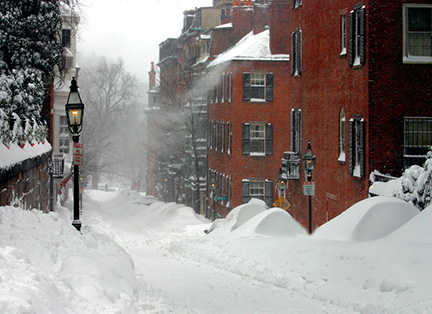Residents in Boston are proud to live in one of the country’s great historical cities, but given its location, Boston is also home to some of the country’s harshest winter weather. As such, Bostonians are typically well prepared for the annual New England snowstorms. Yet, in recent years, even the most seasoned Boston residents have been caught off guard.

The record breaking snowfall during the winter of 2014-2015 pushed Boston’s snow removal services to the limit and frustrated drivers during a series of heavy storms. With snow totals of 108.6 inches, last year’s snowfall proved to be the most since record books started in 1872.
And with heavy snowfall comes additional hazards for residents. Many homeowners felt compelled to manually remove snow from their roofs while building owners in the city worked overtime to ensure that snow and ice buildup on their roofs didn’t break free and threaten pedestrians below. Although efforts were made to enhance the safety of Boston residents, some found themselves to be in the wrong place at the wrong time.
In Cambridge, five individuals walking on a path between the Simoni Ice Skating Arena and sports playing fields were suddenly overwhelmed by snow that fell from the roof of the ice rink. One man was buried, but was eventually dug out from the snow without serious injury. This incident brings to light the unseen hazards of snowfall in large cities.
State law mandates that property owners not only clear their sidewalks for pedestrians, but also take reasonable steps to prevent snow and ice from falling onto pedestrians from roofs and other elevated structures. The ideal solution has proven to be the installation of an automated radiant roof de-icing system.
Roof heating systems are also beneficial for Boston homeowners. Easy to customize and install, roof de-icing and gutter trace systems can keep heavy ice from damaging roof gutters and prevent ice dams from forming along roof edges.
The repair costs from ice dams can be significant. As heat rises and warms the roof, water runs down to the roof’s edge. But the roof is colder at the overhang, and the water refreezes. As this process is repeated, ice and water can build up behind the dam where it can seep into tiny cracks of the roof. Each night, as the water refreezes, it expands, paving the way for more water to seep into the cracks and eventually into the home. The resulting water damage within walls and ceilings can be expensive to repair.
Warmzone roof de-icing and gutter trace systems offer one of the best roof heating solutions available for preventing hazardous ice dams and heavy icicles from forming on roofs. In addition to Warmzone’s large variety of industry leading roof de-icing systems, Warmzone radiant heat experts work closely with customers to determine the best and most affordable option for the roof.
The most popular roof heating system features an advanced polymer heating element (RoofHeat STEP) that can be installed directly under roof shingles. This low-voltage system has proven to be a favorite roof heating solution among professional installers and homeowners throughout New England. Heat trace cable can also be installed to heat gutters and downspouts, or the systems can be combined to produce optimum results.
Warmzone professionals are experts when it comes to roof heating, and its customer service is second to none. In addition to providing complete system designs (AutoCAD), installers have access to free installation training as well as personal installation support. If installers encounter any issues or have any questions during the process, he/she can speak with one of the dedicated installation support staff to resolve the issue.
Many home and business owners in Boston are already enjoying the benefits of a Warmzone roof de-icing system. Call a Warmzone consultant to learn more – with no obligation or sales pressure – at 888.488.9276. As an industry leader, Warmzone offers one of the most informative radiant heating websites available. Visit warmzone.com and learn more about radiant heating systems and why some systems (and services) are better than others when it comes to heating specific projects.
